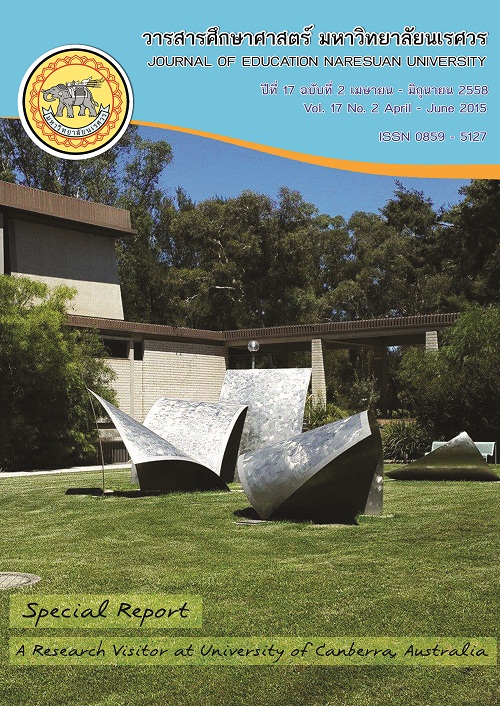ผลการจัดการเรียนรู้แบบวัฎจักรการเรียนรู้ 7 ขั้นร่วมกับเทคนิคหมวก 6 ใบ ที่มีต่อการคิดวิเคราะห์และทักษะกระบวนการทางวิทยาศาสตร์ขั้นบูรณาการ เรื่อง โมเมนตัมและการชนของนักเรียนชั้นมัธยมศึกษาปีที่ 4
Main Article Content
Abstract
บทคัดย่อ
การวิจัยในครั้งนี้มีวัตถุประสงค์คือ 1) เพื่อเปรียบเทียบการคิดวิเคราะห์ของนักเรียนชั้นมัธยมศึกษาปีที่ 4 หลังจากได้รับการจัดการเรียนรู้แบบวัฎจักรการเรียนรู้ 7 ขั้น ร่วมกับเทคนิคหมวก 6 ใบ เรื่อง โมเมนตัมและการชน กับเกณฑ์ร้อยละ 70 2) เพื่อเปรียบเทียบทักษะกระบวนการทางวิทยาศาสตร์ขั้นบูรณาการ ของนักเรียนชั้นมัธยมศึกษาปีที่ 4 หลังจากได้รับการจัดการเรียนรู้แบบวัฎจักรการเรียนรู้ 7 ขั้น ร่วมกับเทคนิคหมวก 6 ใบ เรื่อง โมเมนตัมและการชน กับเกณฑ์ร้อยละ 70
กลุ่มตัวอย่างในงานวิจัยนี้ ได้แก่ นักเรียนชั้นมัธยมศึกษาปีที่ 4/2 จำนวน 50 คน แผนการเรียนวิทยาศาสตร์-คณิตศาสตร์ ในภาคเรียนที่ 2 ปีการศึกษา 2556 โรงเรียนกำแพงเพชรพิทยาคม เขตพื้นที่การศึกษามัธยมศึกษา เขต 41 โดยการเลือกกลุ่มตัวอย่างแบบการสุ่มอย่างง่าย (Purposive Random Sampling) ดำเนินการวิจัยโดยจัดการเรียนรู้แบบวัฎจักรการเรียนรู้ 7 ขั้น ร่วมกับเทคนิคหมวก 6 ใบ นำสถานการณ์หรือรูปภาพที่เกี่ยวข้องกับเรื่องที่เรียนในชีวิตประจำวัน ให้นักเรียนแสดงความคิด ความรู้สึกของตนเอง โดยใช้เทคนิคหมวก 6 ใบ ในขั้นตรวจสอบความรู้เดิม
ขั้นเร้าความสนใจ ขั้นขยายความรู้ และขั้นนำความรู้ไปใช้ รวมเวลาเรียน 16 ชั่วโมง หลังจากเรียนเสร็จในแต่ละเรื่องนักเรียนทำแบบทดสอบทักษะกระบวนการทางวิทยาศาสตร์ขั้นบูรณาการ เป็นแบบทดสอบภาคปฏิบัติ ใช้เวลา 60 นาที เมื่อเรียนเสร็จในเรื่องสุดท้ายนักเรียนทำแบบทดสอบการคิดวิเคราะห์ เป็นแบบทดสอบปรนัย ใช้เวลา 50 นาที
เครื่องมือที่ใช้ในการวิจัยประกอบด้วย 1) แบบทดสอบการคิดวิเคราะห์ เรื่อง โมเมนตัมและการชน เป็นแบบทดสอบปรนัย มีค่าความยากอยู่ในช่วง 0.56 ถึง 0.74 และมีค่าอำนาจจำแนก อยู่ระหว่าง 0.24 ถึง 0.63 ค่าความเชื่อมั่น เท่ากับ 0.81 และ 2) แบบทดสอบทักษะกระบวนการทางวิทยาศาสตร์ขั้นบูรณาการ เรื่อง โมเมนตัมและการชน จำนวน 5 ฉบับ ได้แก่ ฉบับที่ 1 เรื่อง โมเมนตัม ฉบับที่ 2 เรื่อง แรงดลและการดล ฉบับที่ 3 เรื่อง การชน 1 มิติ ฉบับที่ 4 เรื่องการชน 2 มิติ และฉบับที่ 5 เรื่องการระเบิด แบบแผนการวิจัยเป็นแบบ One Group Posttest Design สถิติที่ใช้ในการวิเคราะห์ คือ ร้อยละ, ค่าเฉลี่ย ( ), ค่าเบี่ยงเบนมาตรฐาน (S.D.) และค่าสถิติทดสอบที (t-test แบบ one sample) ผลการศึกษาพบว่า
1. การคิดวิเคราะห์ของนักเรียนชั้นมัธยมศึกษาปีที่ 4 หลังจากได้รับการจัดการเรียนรู้แบบวัฎจักรการเรียนรู้ 7 ขั้นร่วมกับเทคนิคหมวก 6 ใบ เรื่อง โมเมนตัมและการชน มีคะแนนร้อยละ 72.53 สูงกว่าเกณฑ์ร้อยละ 70 อย่างมีนัยสำคัญทางสถิติที่ระดับ .05
2. ทักษะกระบวนการทางวิทยาศาสตร์ขั้นบูรณาการของนักเรียนชั้นมัธยมศึกษาปีที่ 4 หลังจากได้รับการจัดการเรียนรู้แบบวัฎจักรการเรียนรู้ 7 ขั้น ร่วมกับเทคนิคหมวก 6 ใบ เรื่อง โมเมนตัมและการชน มีคะแนนร้อยละ 75.20 สูงกว่าเกณฑ์ร้อยละ 70 อย่างมีนัยสำคัญทางสถิติที่ระดับ .05
คำสำคัญ: วัฎจักรการเรียนรู้ 7 ขั้น/ ทักษะกระบวนการทางวิทยาศาสตร์ขั้นบูรณาการ/ การคิดวิเคราะห์
Abstract
The research purposes were : 1) to compare the Analytical thinking of Matthayomsuksa IV
students after learn with 7E Learning cycle and Six Hats Technique on the topic Momentum and collision, so that mean scores of them could obtain passing criterion 70 percentage of full scores. And 2) to compare the Integrated Science Process skill of Matthayomsuksa IV students after learn with7E Learning cycle and Six Hats Technique on the topic Momentum and collision, so that mean scores of them could obtain passing criterion 70 percentage of full scores.
The sample group in this study were 50 of Matthayomsuksa 4/2 students in Science - Mathematics program at Kamphaengphetpittayakom School, during the second semester of 2013 school year, Secondary Educational Service Area Region 41, drawn through the purposive random sampling. Operated research by teaching 7E Learning cycle and Six Hats Technique used the situation or image related to that subject in everyday life for students show their idea and opinion using Six Hats Technique in phase: Elicitation Phase, Engagement Phase, Expansion Phase and Extension Phase spent 16 hours. Then finished each unit students did the integrated science process skills test, the practical test, 60 minutes. When completed last unit students did the Analytical thinking test, multiple choices test, 50 minutes.
The research instruments compose 1) the Analytical thinking test on the topic Momentum and collision, the test have difficulty between 0.56 to 0.74, the discrimination between 0.24 to 0.63, reliability was 0.81 and 2) the Integrated Science Process skill test on the topic Momentum and collision, 5 the Integrated Science Process skill test composed, the first test was Momentum, the second test was impulsive force and impulse, the third test was one dimension collision, the fourth test was two dimension collision, and fifth test was explosion. Research design is One Group Posttest Design. The statistics which used for data analysis were a percentage, a mean, a standard derivation, and t-test one sample.
According to the study, the results found that :
1. The Analytical thinking of Matthayomsuksa IV students after learning with 7E Learning cycle and Six Hats Technique on the topic Momentum and collision accounted for 72.53 percentage scores was higher than criterion 70 percentage of full scores at the level .05
2. The Integrated Science Process Skills of Matthayomsuksa IV students after learning with 7E Learning cycle and Six Hats Technique on the topic Momentum and collision accounted for 75.20 percentage scores was higher than criterion 70 percentage of full scores at the level .05
Key words: 7E Learning Cycle/ Integrated Science Process Skills/ Analytical Thinking
Article Details
The owner of the article does not copy or violate any of its copyright. If any copyright infringement occurs or prosecution, in any case, the Editorial Board is not involved in all the rights to the owner of the article to be performed.


